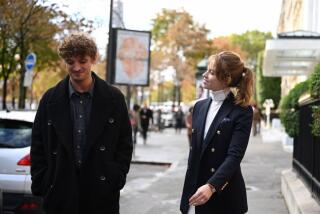MOVIE REVIEWS: ONE WISTFUL, THE OTHER WILD : ‘Radio Days’ Tunes Into Those Innocent Dial-Turning Times
- Share via
Return with us now to those thrilling days of yesteryear . . . to the late 1930s, when everything you knew about the world came from a brown, cathedral-shaped radio--and your imagination. Come away to Woody Allen’s heartfelt, evocative “Radio Days,” a movie that draws you close to it like listeners around that glowing radio dial. (It opens today at selected theaters.)
These are the days of the Masked Avenger and the secret decoder ring; of sports-story spinners who leave not a dry eye in the living room; of breakfast with Irene and Roger and dinner with ventriloquist comedians. These are the folks out there in Radioland, brought back with a rush both affectionate and satiric.
On the other side of the airwaves, out by the ocean in Rockaway, Long Island, is a noisy, struggling, very extended Jewish family. There is young red-headed Joey (Seth Green, who will absolutely grow up to look like Woody Allen) and his eternally wrangling parents (the splendid Julie Kavner and Michael Tucker), and there are Aunt Ceil (Renee Lippin) and Uncle Abe (Josh Mostel), who seem to have sprung from the same Play-Doh mold. And there is the unmarried but radiantly optimistic Aunt Bea (Dianne Wiest), utterly undaunted in her search for Mr. Right among a forest of Mr. Wrongs.
Straitened times are the ostensible reason they’re all under one straining roof, but watching the women practice their conga through the living room, or looking at Bea as she reverently touches her pregnant sister’s rounded stomach, you know that something deeper than necessity is at work here.
This is Allen’s friendliest film yet, though he might squirm away from such a heart-on-the-sleeve notion. Family, again, is at the heart of things; caustic one-liners have given way to genuine evocation. Early in the film you see the gag set up, and you wait for the quick Allen zinger as the ineffably tony Irene and Roger coo their Broadway gossip over their eggs Benedict. We know they’ll be at each other’s throats as soon as the broadcast light blinks off. They aren’t. Allen wants us to savor them the way his Rockaway family does--as legitimate heirs to life’s glittering prizes.
“Radio Days” seems buoyantly simple: the narrator (Allen, unseen) sharing his collection of prize stories from radio’s Golden Age. But, together with the Rockaway family portrait, it becomes an homage to life at either end of the rainbow and both sides of a radio dial during our last innocent era--the late 1930s through 1944. It has a little thread of a story involving a piercing-voiced cigarette girl (Mia Farrow, amazing yet again) and her improbable rise in the wonderful world of radio. Mostly it’s vignettes.
In retrospect, however, “Radio Days” takes on a deeper resonance, a suggestion that these memories, both pure and shamelessly exaggerated, aren’t trivial but the absolute stuff of life, to be collected as seriously as war bonds.
Allen’s enormous cast, in particular the entire Rockaway family, is one sublime ensemble, and if you look sharply you can find curtain calls by past Allen favorites: Danny Aiello, Jeff Daniels, Tony Roberts, a shimmering song by Diane Keaton--even one by Kitty Carlisle Hart, whose rich voice makes “They’re Either Too Young or Too Old” the rueful wartime complaint. . . .
As usual in Allen films, the music of the period (in Dick Hyman’s arrangements) is an express train back in time, and so are Jeffrey Kurland’s superlative costumes. Never have so many beautiful women looked so ravishing in snoods. The glowing cinematography and impeccable editing were by Carlo Di Palma and Susan E. Morse, respectively.
At the close, Allen’s voice says gently: “I’ve never forgotten any of these people. . . although with passing years, those voices seem to grow dimmer and dimmer.”
There is a tender sense of the mature artist, pinning down the ephemeral with the greatest care--letting us know how it felt in 1944 to greet the New Year from a Times Square rooftop, dwarfed by gigantic advertising signs, with a light snow beginning to fall on bare shoulders and dinner jackets. Santo Loquasto’s sets here--and throughout--have as much presence as one of the characters, and this Times Square panorama, at once realistic and emotionally exaggerated, is his finest moment.
One of the men on that rooftop (is it the Masked Avenger?), worries gently whether future generations will ever hear about them. Of course they will. They have Woody Allen to see that they do.
More to Read
Only good movies
Get the Indie Focus newsletter, Mark Olsen's weekly guide to the world of cinema.
You may occasionally receive promotional content from the Los Angeles Times.










